Strategic Practices: Analysis of System Thinking and Strategy
VerifiedAdded on 2020/06/06
|14
|4469
|61
Report
AI Summary
This report delves into strategic practices, emphasizing their crucial role in achieving organizational goals. It critically examines key themes like strategic thinking, which provides a framework for adapting to external changes, and systems thinking, which promotes a holistic understanding of interconnected organizational departments. The report explores the complexity perspective, discussing tools such as SWOT and PESTLE analyses, and Porter's Five Forces to assess market competition. It also considers complex adaptive systems and the practice perspective, highlighting the application of these concepts through examples like the retailer Aji Ichiban. The report emphasizes the importance of strategic alignment, leadership, and the use of various strategic management tools for effective decision-making and achieving competitive advantage. This report is designed to provide insights into the application of strategic practices, systems thinking, and the utilization of strategic tools for improved business outcomes.
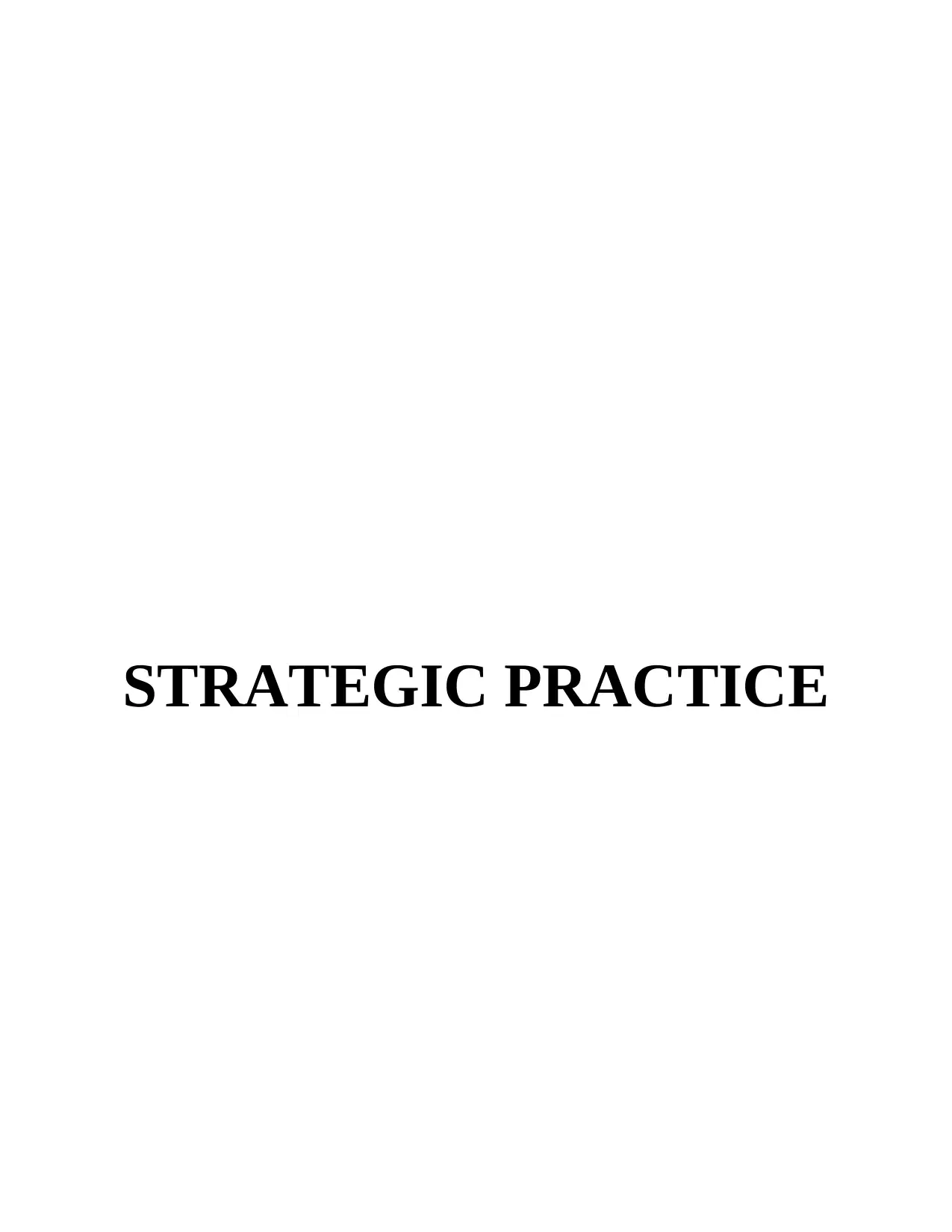
STRATEGIC PRACTICE
Paraphrase This Document
Need a fresh take? Get an instant paraphrase of this document with our AI Paraphraser

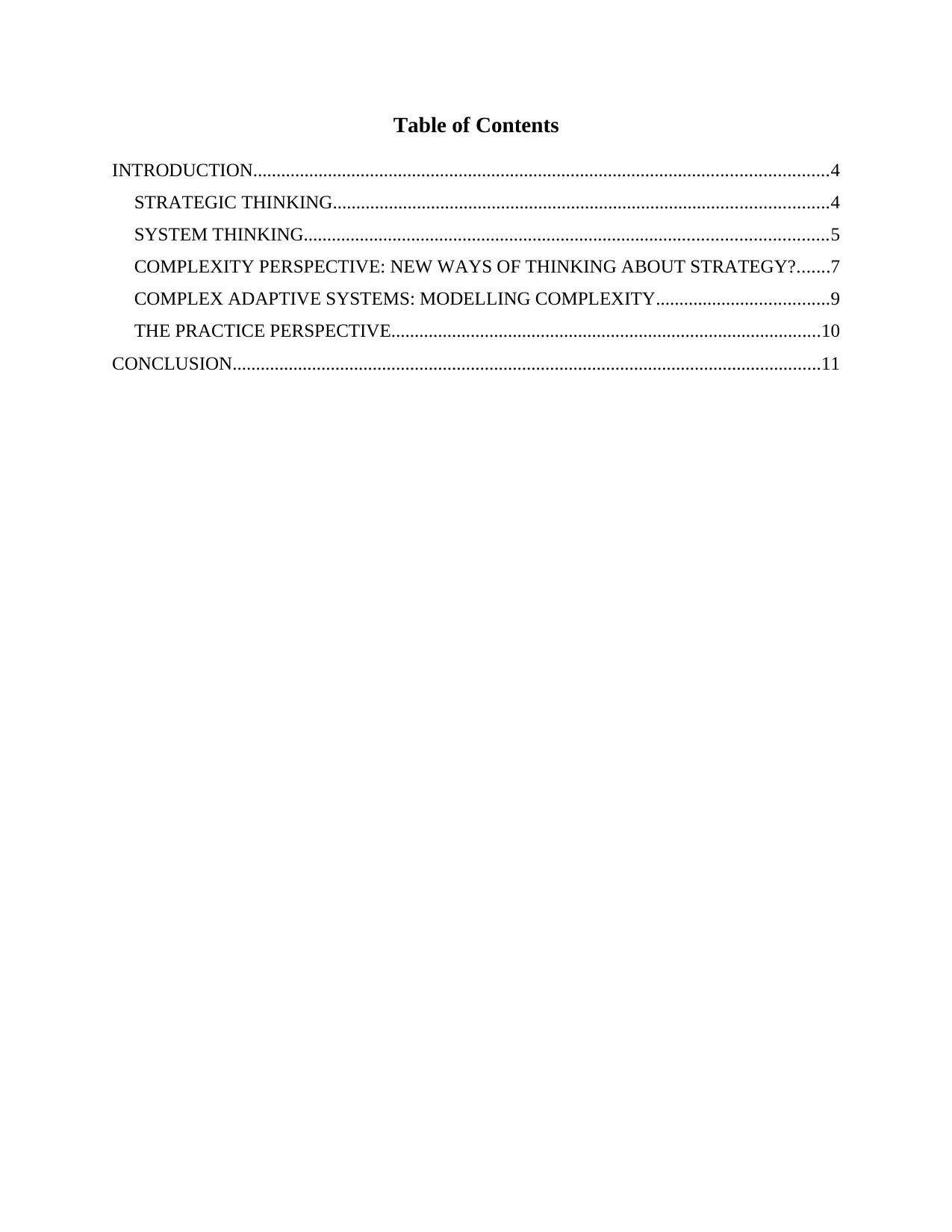
Table of Contents
INTRODUCTION...........................................................................................................................4
STRATEGIC THINKING..........................................................................................................4
SYSTEM THINKING................................................................................................................5
COMPLEXITY PERSPECTIVE: NEW WAYS OF THINKING ABOUT STRATEGY?.......7
COMPLEX ADAPTIVE SYSTEMS: MODELLING COMPLEXITY.....................................9
THE PRACTICE PERSPECTIVE............................................................................................10
CONCLUSION..............................................................................................................................11
INTRODUCTION...........................................................................................................................4
STRATEGIC THINKING..........................................................................................................4
SYSTEM THINKING................................................................................................................5
COMPLEXITY PERSPECTIVE: NEW WAYS OF THINKING ABOUT STRATEGY?.......7
COMPLEX ADAPTIVE SYSTEMS: MODELLING COMPLEXITY.....................................9
THE PRACTICE PERSPECTIVE............................................................................................10
CONCLUSION..............................................................................................................................11
⊘ This is a preview!⊘
Do you want full access?
Subscribe today to unlock all pages.

Trusted by 1+ million students worldwide
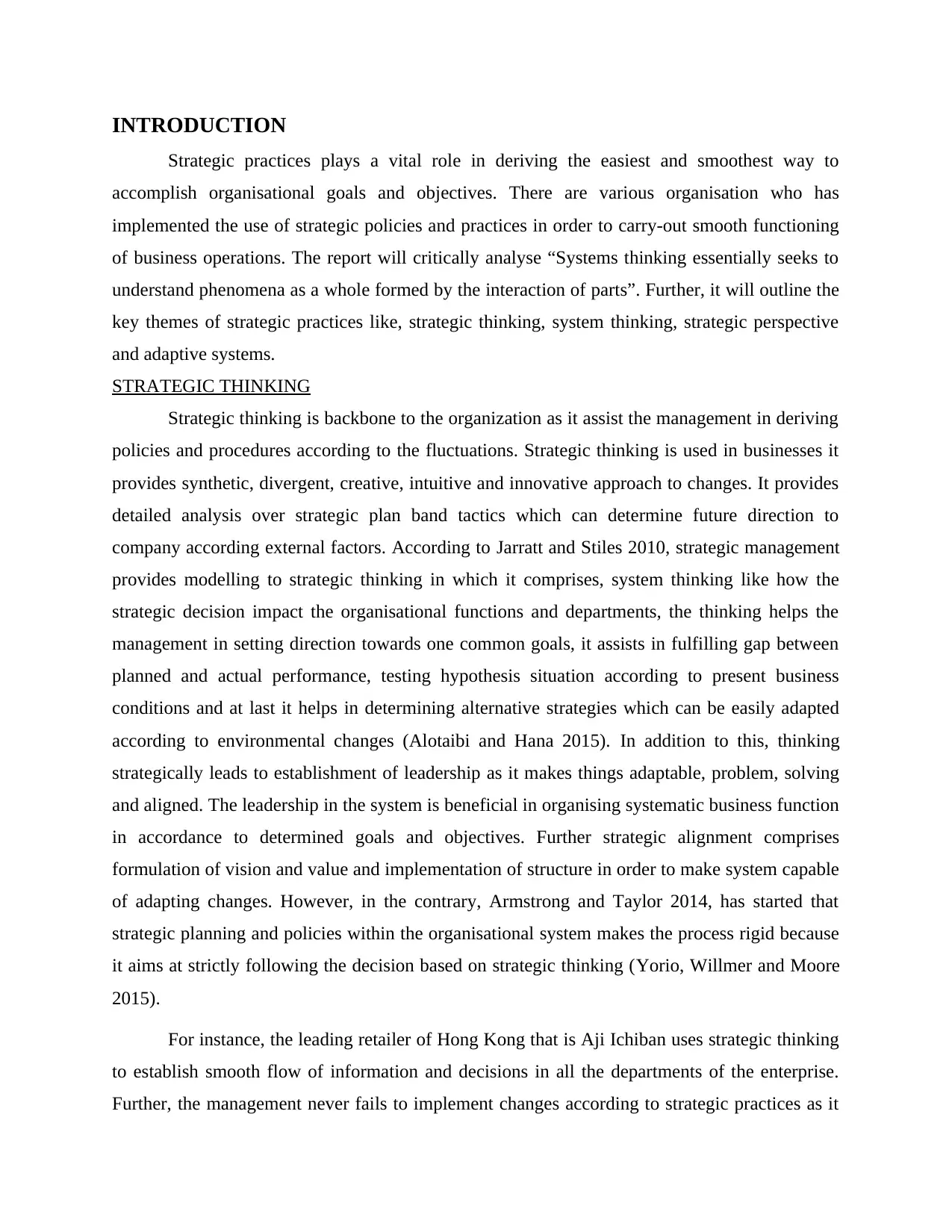
INTRODUCTION
Strategic practices plays a vital role in deriving the easiest and smoothest way to
accomplish organisational goals and objectives. There are various organisation who has
implemented the use of strategic policies and practices in order to carry-out smooth functioning
of business operations. The report will critically analyse “Systems thinking essentially seeks to
understand phenomena as a whole formed by the interaction of parts”. Further, it will outline the
key themes of strategic practices like, strategic thinking, system thinking, strategic perspective
and adaptive systems.
STRATEGIC THINKING
Strategic thinking is backbone to the organization as it assist the management in deriving
policies and procedures according to the fluctuations. Strategic thinking is used in businesses it
provides synthetic, divergent, creative, intuitive and innovative approach to changes. It provides
detailed analysis over strategic plan band tactics which can determine future direction to
company according external factors. According to Jarratt and Stiles 2010, strategic management
provides modelling to strategic thinking in which it comprises, system thinking like how the
strategic decision impact the organisational functions and departments, the thinking helps the
management in setting direction towards one common goals, it assists in fulfilling gap between
planned and actual performance, testing hypothesis situation according to present business
conditions and at last it helps in determining alternative strategies which can be easily adapted
according to environmental changes (Alotaibi and Hana 2015). In addition to this, thinking
strategically leads to establishment of leadership as it makes things adaptable, problem, solving
and aligned. The leadership in the system is beneficial in organising systematic business function
in accordance to determined goals and objectives. Further strategic alignment comprises
formulation of vision and value and implementation of structure in order to make system capable
of adapting changes. However, in the contrary, Armstrong and Taylor 2014, has started that
strategic planning and policies within the organisational system makes the process rigid because
it aims at strictly following the decision based on strategic thinking (Yorio, Willmer and Moore
2015).
For instance, the leading retailer of Hong Kong that is Aji Ichiban uses strategic thinking
to establish smooth flow of information and decisions in all the departments of the enterprise.
Further, the management never fails to implement changes according to strategic practices as it
Strategic practices plays a vital role in deriving the easiest and smoothest way to
accomplish organisational goals and objectives. There are various organisation who has
implemented the use of strategic policies and practices in order to carry-out smooth functioning
of business operations. The report will critically analyse “Systems thinking essentially seeks to
understand phenomena as a whole formed by the interaction of parts”. Further, it will outline the
key themes of strategic practices like, strategic thinking, system thinking, strategic perspective
and adaptive systems.
STRATEGIC THINKING
Strategic thinking is backbone to the organization as it assist the management in deriving
policies and procedures according to the fluctuations. Strategic thinking is used in businesses it
provides synthetic, divergent, creative, intuitive and innovative approach to changes. It provides
detailed analysis over strategic plan band tactics which can determine future direction to
company according external factors. According to Jarratt and Stiles 2010, strategic management
provides modelling to strategic thinking in which it comprises, system thinking like how the
strategic decision impact the organisational functions and departments, the thinking helps the
management in setting direction towards one common goals, it assists in fulfilling gap between
planned and actual performance, testing hypothesis situation according to present business
conditions and at last it helps in determining alternative strategies which can be easily adapted
according to environmental changes (Alotaibi and Hana 2015). In addition to this, thinking
strategically leads to establishment of leadership as it makes things adaptable, problem, solving
and aligned. The leadership in the system is beneficial in organising systematic business function
in accordance to determined goals and objectives. Further strategic alignment comprises
formulation of vision and value and implementation of structure in order to make system capable
of adapting changes. However, in the contrary, Armstrong and Taylor 2014, has started that
strategic planning and policies within the organisational system makes the process rigid because
it aims at strictly following the decision based on strategic thinking (Yorio, Willmer and Moore
2015).
For instance, the leading retailer of Hong Kong that is Aji Ichiban uses strategic thinking
to establish smooth flow of information and decisions in all the departments of the enterprise.
Further, the management never fails to implement changes according to strategic practices as it
Paraphrase This Document
Need a fresh take? Get an instant paraphrase of this document with our AI Paraphraser
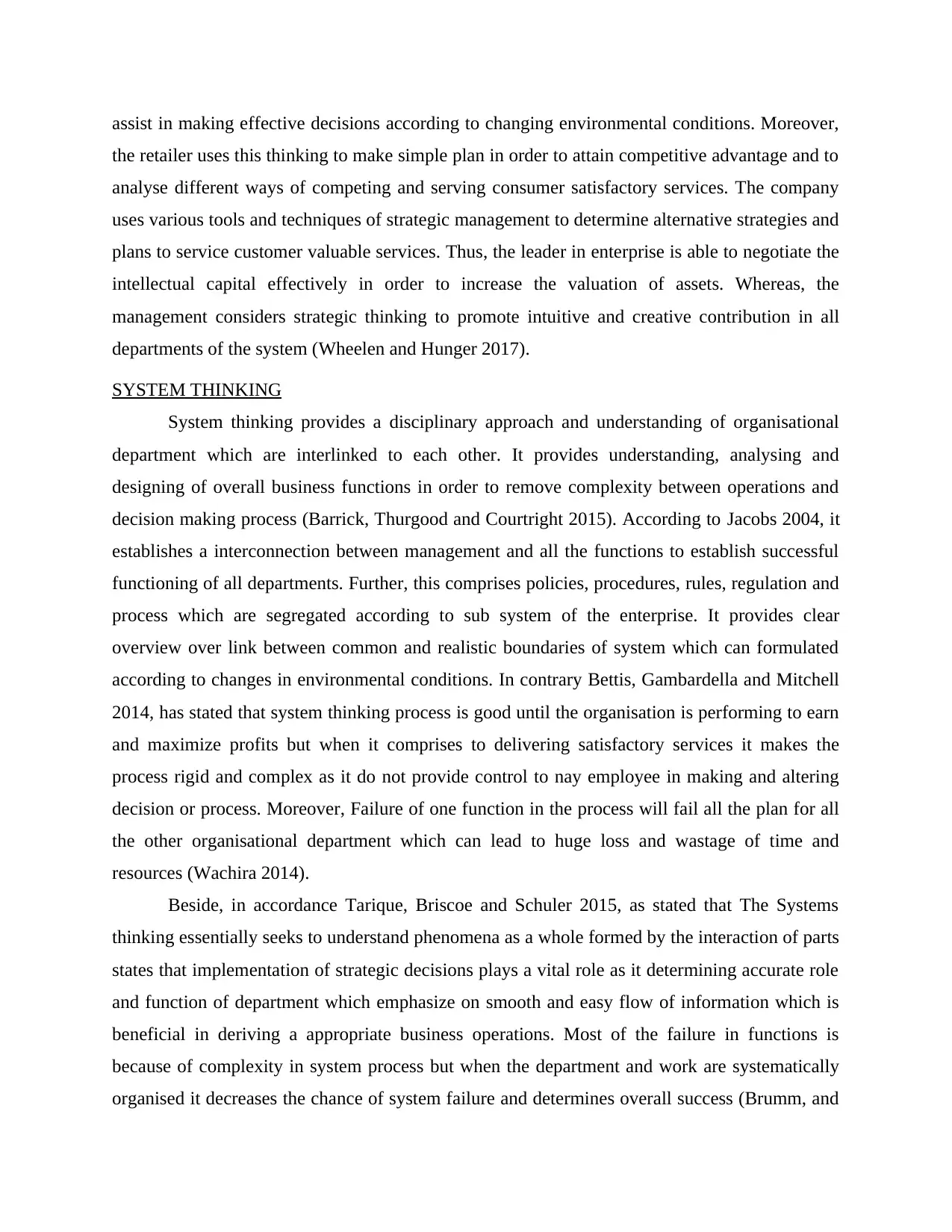
assist in making effective decisions according to changing environmental conditions. Moreover,
the retailer uses this thinking to make simple plan in order to attain competitive advantage and to
analyse different ways of competing and serving consumer satisfactory services. The company
uses various tools and techniques of strategic management to determine alternative strategies and
plans to service customer valuable services. Thus, the leader in enterprise is able to negotiate the
intellectual capital effectively in order to increase the valuation of assets. Whereas, the
management considers strategic thinking to promote intuitive and creative contribution in all
departments of the system (Wheelen and Hunger 2017).
SYSTEM THINKING
System thinking provides a disciplinary approach and understanding of organisational
department which are interlinked to each other. It provides understanding, analysing and
designing of overall business functions in order to remove complexity between operations and
decision making process (Barrick, Thurgood and Courtright 2015). According to Jacobs 2004, it
establishes a interconnection between management and all the functions to establish successful
functioning of all departments. Further, this comprises policies, procedures, rules, regulation and
process which are segregated according to sub system of the enterprise. It provides clear
overview over link between common and realistic boundaries of system which can formulated
according to changes in environmental conditions. In contrary Bettis, Gambardella and Mitchell
2014, has stated that system thinking process is good until the organisation is performing to earn
and maximize profits but when it comprises to delivering satisfactory services it makes the
process rigid and complex as it do not provide control to nay employee in making and altering
decision or process. Moreover, Failure of one function in the process will fail all the plan for all
the other organisational department which can lead to huge loss and wastage of time and
resources (Wachira 2014).
Beside, in accordance Tarique, Briscoe and Schuler 2015, as stated that The Systems
thinking essentially seeks to understand phenomena as a whole formed by the interaction of parts
states that implementation of strategic decisions plays a vital role as it determining accurate role
and function of department which emphasize on smooth and easy flow of information which is
beneficial in deriving a appropriate business operations. Most of the failure in functions is
because of complexity in system process but when the department and work are systematically
organised it decreases the chance of system failure and determines overall success (Brumm, and
the retailer uses this thinking to make simple plan in order to attain competitive advantage and to
analyse different ways of competing and serving consumer satisfactory services. The company
uses various tools and techniques of strategic management to determine alternative strategies and
plans to service customer valuable services. Thus, the leader in enterprise is able to negotiate the
intellectual capital effectively in order to increase the valuation of assets. Whereas, the
management considers strategic thinking to promote intuitive and creative contribution in all
departments of the system (Wheelen and Hunger 2017).
SYSTEM THINKING
System thinking provides a disciplinary approach and understanding of organisational
department which are interlinked to each other. It provides understanding, analysing and
designing of overall business functions in order to remove complexity between operations and
decision making process (Barrick, Thurgood and Courtright 2015). According to Jacobs 2004, it
establishes a interconnection between management and all the functions to establish successful
functioning of all departments. Further, this comprises policies, procedures, rules, regulation and
process which are segregated according to sub system of the enterprise. It provides clear
overview over link between common and realistic boundaries of system which can formulated
according to changes in environmental conditions. In contrary Bettis, Gambardella and Mitchell
2014, has stated that system thinking process is good until the organisation is performing to earn
and maximize profits but when it comprises to delivering satisfactory services it makes the
process rigid and complex as it do not provide control to nay employee in making and altering
decision or process. Moreover, Failure of one function in the process will fail all the plan for all
the other organisational department which can lead to huge loss and wastage of time and
resources (Wachira 2014).
Beside, in accordance Tarique, Briscoe and Schuler 2015, as stated that The Systems
thinking essentially seeks to understand phenomena as a whole formed by the interaction of parts
states that implementation of strategic decisions plays a vital role as it determining accurate role
and function of department which emphasize on smooth and easy flow of information which is
beneficial in deriving a appropriate business operations. Most of the failure in functions is
because of complexity in system process but when the department and work are systematically
organised it decreases the chance of system failure and determines overall success (Brumm, and
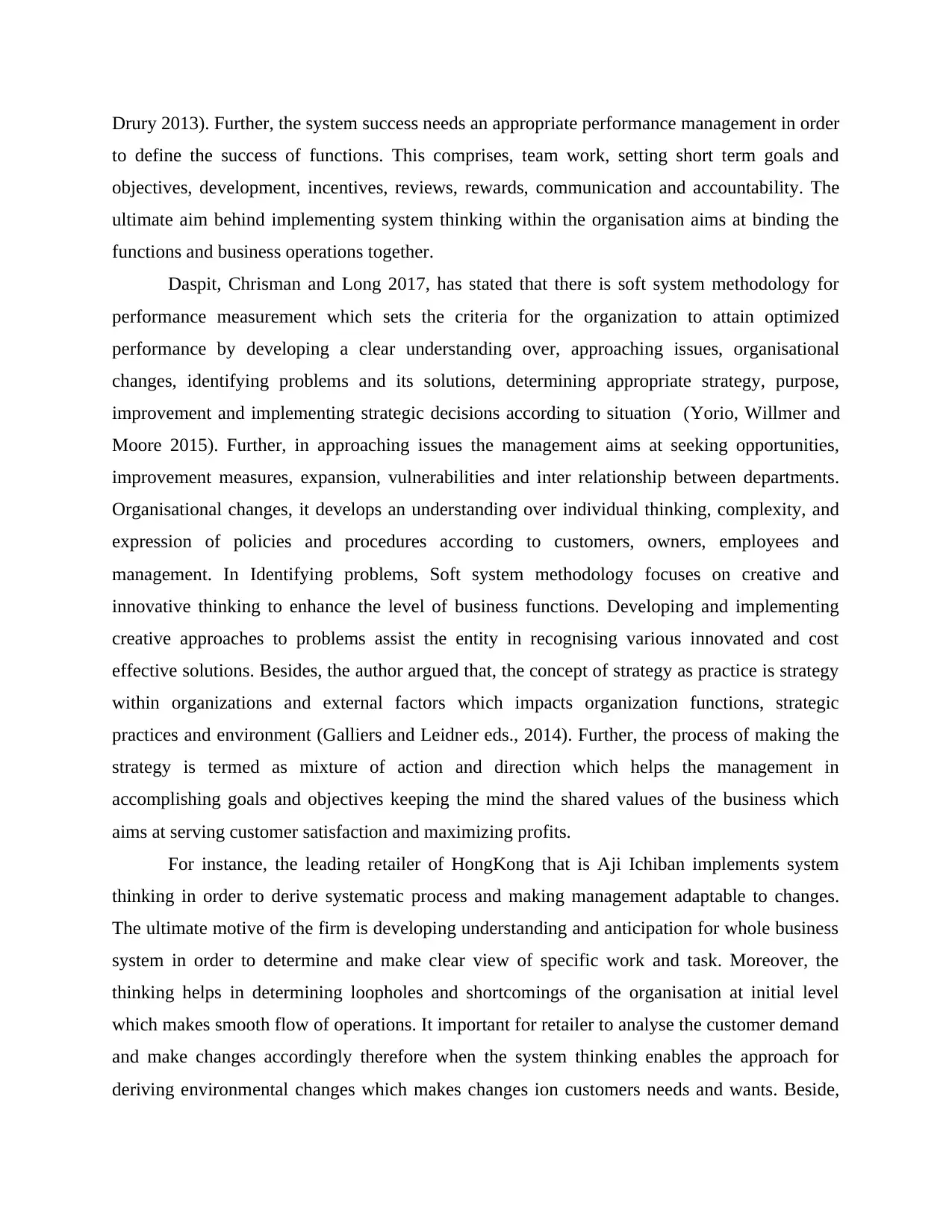
Drury 2013). Further, the system success needs an appropriate performance management in order
to define the success of functions. This comprises, team work, setting short term goals and
objectives, development, incentives, reviews, rewards, communication and accountability. The
ultimate aim behind implementing system thinking within the organisation aims at binding the
functions and business operations together.
Daspit, Chrisman and Long 2017, has stated that there is soft system methodology for
performance measurement which sets the criteria for the organization to attain optimized
performance by developing a clear understanding over, approaching issues, organisational
changes, identifying problems and its solutions, determining appropriate strategy, purpose,
improvement and implementing strategic decisions according to situation (Yorio, Willmer and
Moore 2015). Further, in approaching issues the management aims at seeking opportunities,
improvement measures, expansion, vulnerabilities and inter relationship between departments.
Organisational changes, it develops an understanding over individual thinking, complexity, and
expression of policies and procedures according to customers, owners, employees and
management. In Identifying problems, Soft system methodology focuses on creative and
innovative thinking to enhance the level of business functions. Developing and implementing
creative approaches to problems assist the entity in recognising various innovated and cost
effective solutions. Besides, the author argued that, the concept of strategy as practice is strategy
within organizations and external factors which impacts organization functions, strategic
practices and environment (Galliers and Leidner eds., 2014). Further, the process of making the
strategy is termed as mixture of action and direction which helps the management in
accomplishing goals and objectives keeping the mind the shared values of the business which
aims at serving customer satisfaction and maximizing profits.
For instance, the leading retailer of HongKong that is Aji Ichiban implements system
thinking in order to derive systematic process and making management adaptable to changes.
The ultimate motive of the firm is developing understanding and anticipation for whole business
system in order to determine and make clear view of specific work and task. Moreover, the
thinking helps in determining loopholes and shortcomings of the organisation at initial level
which makes smooth flow of operations. It important for retailer to analyse the customer demand
and make changes accordingly therefore when the system thinking enables the approach for
deriving environmental changes which makes changes ion customers needs and wants. Beside,
to define the success of functions. This comprises, team work, setting short term goals and
objectives, development, incentives, reviews, rewards, communication and accountability. The
ultimate aim behind implementing system thinking within the organisation aims at binding the
functions and business operations together.
Daspit, Chrisman and Long 2017, has stated that there is soft system methodology for
performance measurement which sets the criteria for the organization to attain optimized
performance by developing a clear understanding over, approaching issues, organisational
changes, identifying problems and its solutions, determining appropriate strategy, purpose,
improvement and implementing strategic decisions according to situation (Yorio, Willmer and
Moore 2015). Further, in approaching issues the management aims at seeking opportunities,
improvement measures, expansion, vulnerabilities and inter relationship between departments.
Organisational changes, it develops an understanding over individual thinking, complexity, and
expression of policies and procedures according to customers, owners, employees and
management. In Identifying problems, Soft system methodology focuses on creative and
innovative thinking to enhance the level of business functions. Developing and implementing
creative approaches to problems assist the entity in recognising various innovated and cost
effective solutions. Besides, the author argued that, the concept of strategy as practice is strategy
within organizations and external factors which impacts organization functions, strategic
practices and environment (Galliers and Leidner eds., 2014). Further, the process of making the
strategy is termed as mixture of action and direction which helps the management in
accomplishing goals and objectives keeping the mind the shared values of the business which
aims at serving customer satisfaction and maximizing profits.
For instance, the leading retailer of HongKong that is Aji Ichiban implements system
thinking in order to derive systematic process and making management adaptable to changes.
The ultimate motive of the firm is developing understanding and anticipation for whole business
system in order to determine and make clear view of specific work and task. Moreover, the
thinking helps in determining loopholes and shortcomings of the organisation at initial level
which makes smooth flow of operations. It important for retailer to analyse the customer demand
and make changes accordingly therefore when the system thinking enables the approach for
deriving environmental changes which makes changes ion customers needs and wants. Beside,
⊘ This is a preview!⊘
Do you want full access?
Subscribe today to unlock all pages.

Trusted by 1+ million students worldwide
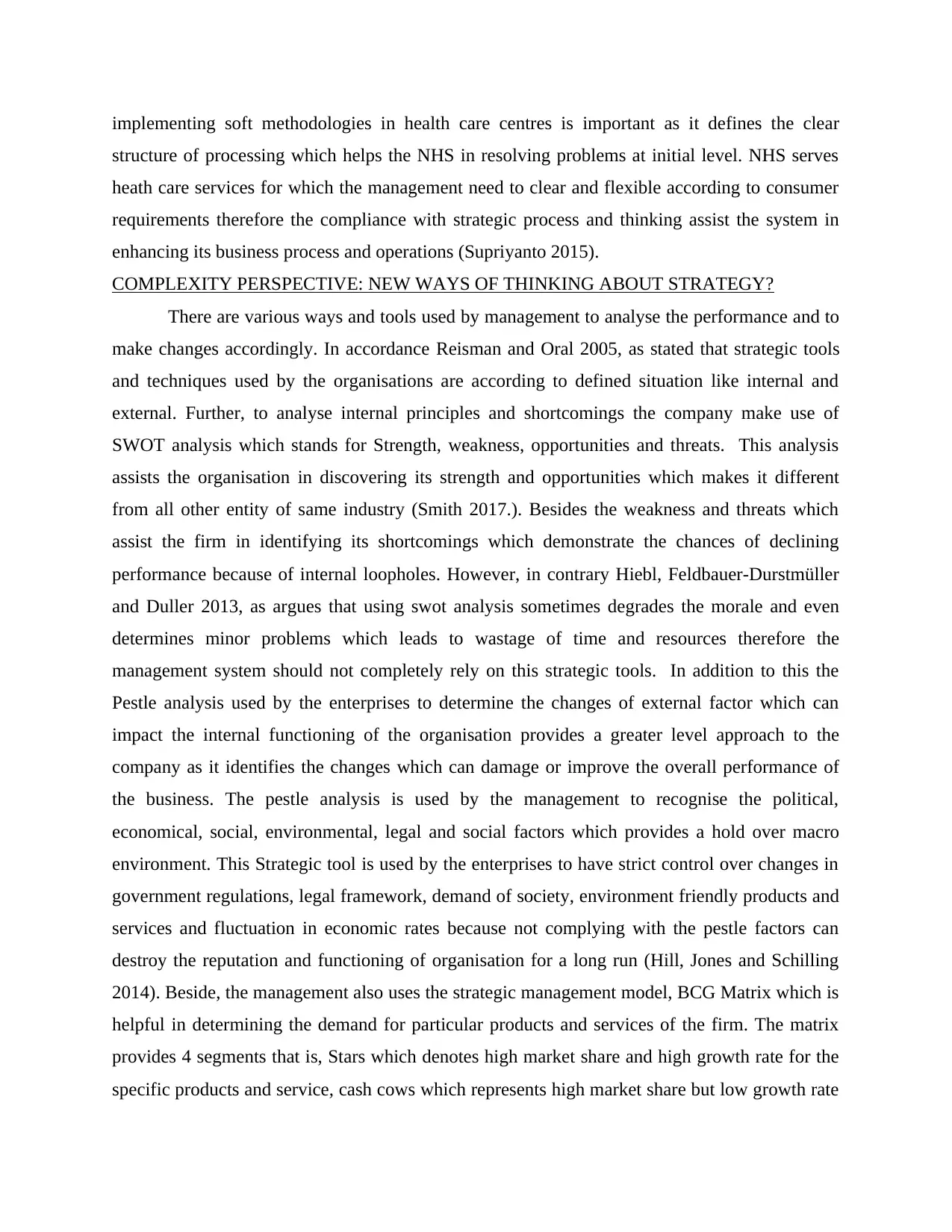
implementing soft methodologies in health care centres is important as it defines the clear
structure of processing which helps the NHS in resolving problems at initial level. NHS serves
heath care services for which the management need to clear and flexible according to consumer
requirements therefore the compliance with strategic process and thinking assist the system in
enhancing its business process and operations (Supriyanto 2015).
COMPLEXITY PERSPECTIVE: NEW WAYS OF THINKING ABOUT STRATEGY?
There are various ways and tools used by management to analyse the performance and to
make changes accordingly. In accordance Reisman and Oral 2005, as stated that strategic tools
and techniques used by the organisations are according to defined situation like internal and
external. Further, to analyse internal principles and shortcomings the company make use of
SWOT analysis which stands for Strength, weakness, opportunities and threats. This analysis
assists the organisation in discovering its strength and opportunities which makes it different
from all other entity of same industry (Smith 2017.). Besides the weakness and threats which
assist the firm in identifying its shortcomings which demonstrate the chances of declining
performance because of internal loopholes. However, in contrary Hiebl, Feldbauer-Durstmüller
and Duller 2013, as argues that using swot analysis sometimes degrades the morale and even
determines minor problems which leads to wastage of time and resources therefore the
management system should not completely rely on this strategic tools. In addition to this the
Pestle analysis used by the enterprises to determine the changes of external factor which can
impact the internal functioning of the organisation provides a greater level approach to the
company as it identifies the changes which can damage or improve the overall performance of
the business. The pestle analysis is used by the management to recognise the political,
economical, social, environmental, legal and social factors which provides a hold over macro
environment. This Strategic tool is used by the enterprises to have strict control over changes in
government regulations, legal framework, demand of society, environment friendly products and
services and fluctuation in economic rates because not complying with the pestle factors can
destroy the reputation and functioning of organisation for a long run (Hill, Jones and Schilling
2014). Beside, the management also uses the strategic management model, BCG Matrix which is
helpful in determining the demand for particular products and services of the firm. The matrix
provides 4 segments that is, Stars which denotes high market share and high growth rate for the
specific products and service, cash cows which represents high market share but low growth rate
structure of processing which helps the NHS in resolving problems at initial level. NHS serves
heath care services for which the management need to clear and flexible according to consumer
requirements therefore the compliance with strategic process and thinking assist the system in
enhancing its business process and operations (Supriyanto 2015).
COMPLEXITY PERSPECTIVE: NEW WAYS OF THINKING ABOUT STRATEGY?
There are various ways and tools used by management to analyse the performance and to
make changes accordingly. In accordance Reisman and Oral 2005, as stated that strategic tools
and techniques used by the organisations are according to defined situation like internal and
external. Further, to analyse internal principles and shortcomings the company make use of
SWOT analysis which stands for Strength, weakness, opportunities and threats. This analysis
assists the organisation in discovering its strength and opportunities which makes it different
from all other entity of same industry (Smith 2017.). Besides the weakness and threats which
assist the firm in identifying its shortcomings which demonstrate the chances of declining
performance because of internal loopholes. However, in contrary Hiebl, Feldbauer-Durstmüller
and Duller 2013, as argues that using swot analysis sometimes degrades the morale and even
determines minor problems which leads to wastage of time and resources therefore the
management system should not completely rely on this strategic tools. In addition to this the
Pestle analysis used by the enterprises to determine the changes of external factor which can
impact the internal functioning of the organisation provides a greater level approach to the
company as it identifies the changes which can damage or improve the overall performance of
the business. The pestle analysis is used by the management to recognise the political,
economical, social, environmental, legal and social factors which provides a hold over macro
environment. This Strategic tool is used by the enterprises to have strict control over changes in
government regulations, legal framework, demand of society, environment friendly products and
services and fluctuation in economic rates because not complying with the pestle factors can
destroy the reputation and functioning of organisation for a long run (Hill, Jones and Schilling
2014). Beside, the management also uses the strategic management model, BCG Matrix which is
helpful in determining the demand for particular products and services of the firm. The matrix
provides 4 segments that is, Stars which denotes high market share and high growth rate for the
specific products and service, cash cows which represents high market share but low growth rate
Paraphrase This Document
Need a fresh take? Get an instant paraphrase of this document with our AI Paraphraser
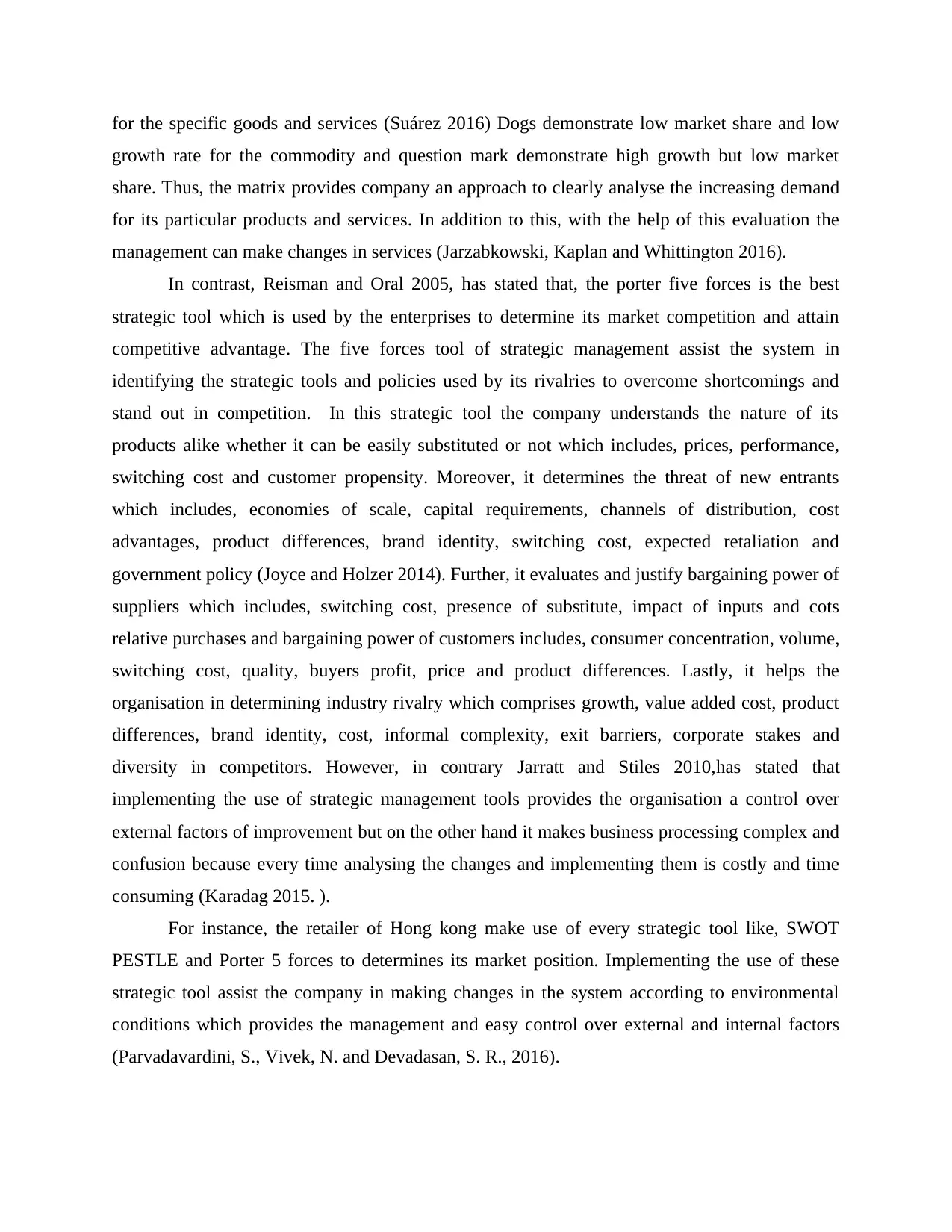
for the specific goods and services (Suárez 2016) Dogs demonstrate low market share and low
growth rate for the commodity and question mark demonstrate high growth but low market
share. Thus, the matrix provides company an approach to clearly analyse the increasing demand
for its particular products and services. In addition to this, with the help of this evaluation the
management can make changes in services (Jarzabkowski, Kaplan and Whittington 2016).
In contrast, Reisman and Oral 2005, has stated that, the porter five forces is the best
strategic tool which is used by the enterprises to determine its market competition and attain
competitive advantage. The five forces tool of strategic management assist the system in
identifying the strategic tools and policies used by its rivalries to overcome shortcomings and
stand out in competition. In this strategic tool the company understands the nature of its
products alike whether it can be easily substituted or not which includes, prices, performance,
switching cost and customer propensity. Moreover, it determines the threat of new entrants
which includes, economies of scale, capital requirements, channels of distribution, cost
advantages, product differences, brand identity, switching cost, expected retaliation and
government policy (Joyce and Holzer 2014). Further, it evaluates and justify bargaining power of
suppliers which includes, switching cost, presence of substitute, impact of inputs and cots
relative purchases and bargaining power of customers includes, consumer concentration, volume,
switching cost, quality, buyers profit, price and product differences. Lastly, it helps the
organisation in determining industry rivalry which comprises growth, value added cost, product
differences, brand identity, cost, informal complexity, exit barriers, corporate stakes and
diversity in competitors. However, in contrary Jarratt and Stiles 2010,has stated that
implementing the use of strategic management tools provides the organisation a control over
external factors of improvement but on the other hand it makes business processing complex and
confusion because every time analysing the changes and implementing them is costly and time
consuming (Karadag 2015. ).
For instance, the retailer of Hong kong make use of every strategic tool like, SWOT
PESTLE and Porter 5 forces to determines its market position. Implementing the use of these
strategic tool assist the company in making changes in the system according to environmental
conditions which provides the management and easy control over external and internal factors
(Parvadavardini, S., Vivek, N. and Devadasan, S. R., 2016).
growth rate for the commodity and question mark demonstrate high growth but low market
share. Thus, the matrix provides company an approach to clearly analyse the increasing demand
for its particular products and services. In addition to this, with the help of this evaluation the
management can make changes in services (Jarzabkowski, Kaplan and Whittington 2016).
In contrast, Reisman and Oral 2005, has stated that, the porter five forces is the best
strategic tool which is used by the enterprises to determine its market competition and attain
competitive advantage. The five forces tool of strategic management assist the system in
identifying the strategic tools and policies used by its rivalries to overcome shortcomings and
stand out in competition. In this strategic tool the company understands the nature of its
products alike whether it can be easily substituted or not which includes, prices, performance,
switching cost and customer propensity. Moreover, it determines the threat of new entrants
which includes, economies of scale, capital requirements, channels of distribution, cost
advantages, product differences, brand identity, switching cost, expected retaliation and
government policy (Joyce and Holzer 2014). Further, it evaluates and justify bargaining power of
suppliers which includes, switching cost, presence of substitute, impact of inputs and cots
relative purchases and bargaining power of customers includes, consumer concentration, volume,
switching cost, quality, buyers profit, price and product differences. Lastly, it helps the
organisation in determining industry rivalry which comprises growth, value added cost, product
differences, brand identity, cost, informal complexity, exit barriers, corporate stakes and
diversity in competitors. However, in contrary Jarratt and Stiles 2010,has stated that
implementing the use of strategic management tools provides the organisation a control over
external factors of improvement but on the other hand it makes business processing complex and
confusion because every time analysing the changes and implementing them is costly and time
consuming (Karadag 2015. ).
For instance, the retailer of Hong kong make use of every strategic tool like, SWOT
PESTLE and Porter 5 forces to determines its market position. Implementing the use of these
strategic tool assist the company in making changes in the system according to environmental
conditions which provides the management and easy control over external and internal factors
(Parvadavardini, S., Vivek, N. and Devadasan, S. R., 2016).
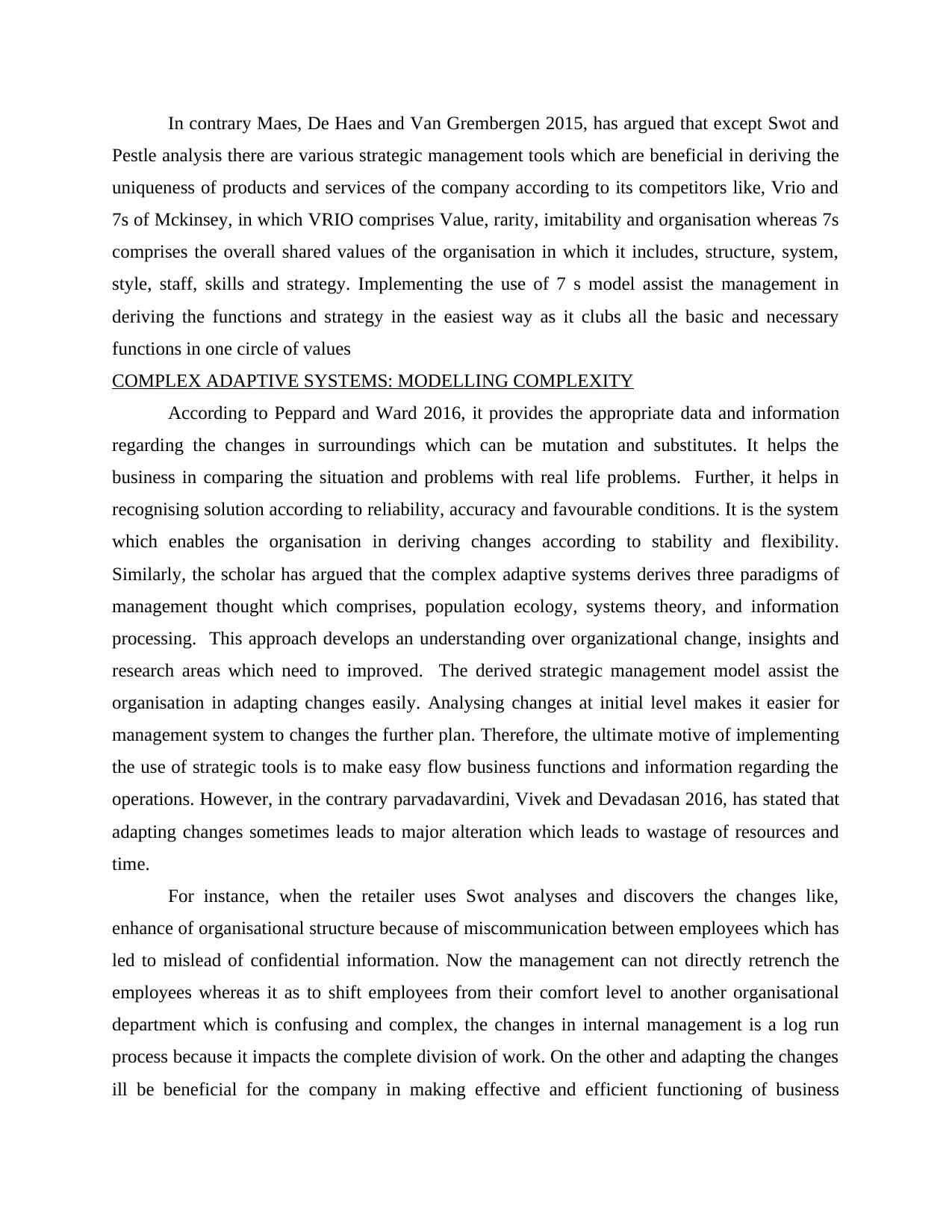
In contrary Maes, De Haes and Van Grembergen 2015, has argued that except Swot and
Pestle analysis there are various strategic management tools which are beneficial in deriving the
uniqueness of products and services of the company according to its competitors like, Vrio and
7s of Mckinsey, in which VRIO comprises Value, rarity, imitability and organisation whereas 7s
comprises the overall shared values of the organisation in which it includes, structure, system,
style, staff, skills and strategy. Implementing the use of 7 s model assist the management in
deriving the functions and strategy in the easiest way as it clubs all the basic and necessary
functions in one circle of values
COMPLEX ADAPTIVE SYSTEMS: MODELLING COMPLEXITY
According to Peppard and Ward 2016, it provides the appropriate data and information
regarding the changes in surroundings which can be mutation and substitutes. It helps the
business in comparing the situation and problems with real life problems. Further, it helps in
recognising solution according to reliability, accuracy and favourable conditions. It is the system
which enables the organisation in deriving changes according to stability and flexibility.
Similarly, the scholar has argued that the complex adaptive systems derives three paradigms of
management thought which comprises, population ecology, systems theory, and information
processing. This approach develops an understanding over organizational change, insights and
research areas which need to improved. The derived strategic management model assist the
organisation in adapting changes easily. Analysing changes at initial level makes it easier for
management system to changes the further plan. Therefore, the ultimate motive of implementing
the use of strategic tools is to make easy flow business functions and information regarding the
operations. However, in the contrary parvadavardini, Vivek and Devadasan 2016, has stated that
adapting changes sometimes leads to major alteration which leads to wastage of resources and
time.
For instance, when the retailer uses Swot analyses and discovers the changes like,
enhance of organisational structure because of miscommunication between employees which has
led to mislead of confidential information. Now the management can not directly retrench the
employees whereas it as to shift employees from their comfort level to another organisational
department which is confusing and complex, the changes in internal management is a log run
process because it impacts the complete division of work. On the other and adapting the changes
ill be beneficial for the company in making effective and efficient functioning of business
Pestle analysis there are various strategic management tools which are beneficial in deriving the
uniqueness of products and services of the company according to its competitors like, Vrio and
7s of Mckinsey, in which VRIO comprises Value, rarity, imitability and organisation whereas 7s
comprises the overall shared values of the organisation in which it includes, structure, system,
style, staff, skills and strategy. Implementing the use of 7 s model assist the management in
deriving the functions and strategy in the easiest way as it clubs all the basic and necessary
functions in one circle of values
COMPLEX ADAPTIVE SYSTEMS: MODELLING COMPLEXITY
According to Peppard and Ward 2016, it provides the appropriate data and information
regarding the changes in surroundings which can be mutation and substitutes. It helps the
business in comparing the situation and problems with real life problems. Further, it helps in
recognising solution according to reliability, accuracy and favourable conditions. It is the system
which enables the organisation in deriving changes according to stability and flexibility.
Similarly, the scholar has argued that the complex adaptive systems derives three paradigms of
management thought which comprises, population ecology, systems theory, and information
processing. This approach develops an understanding over organizational change, insights and
research areas which need to improved. The derived strategic management model assist the
organisation in adapting changes easily. Analysing changes at initial level makes it easier for
management system to changes the further plan. Therefore, the ultimate motive of implementing
the use of strategic tools is to make easy flow business functions and information regarding the
operations. However, in the contrary parvadavardini, Vivek and Devadasan 2016, has stated that
adapting changes sometimes leads to major alteration which leads to wastage of resources and
time.
For instance, when the retailer uses Swot analyses and discovers the changes like,
enhance of organisational structure because of miscommunication between employees which has
led to mislead of confidential information. Now the management can not directly retrench the
employees whereas it as to shift employees from their comfort level to another organisational
department which is confusing and complex, the changes in internal management is a log run
process because it impacts the complete division of work. On the other and adapting the changes
ill be beneficial for the company in making effective and efficient functioning of business
⊘ This is a preview!⊘
Do you want full access?
Subscribe today to unlock all pages.

Trusted by 1+ million students worldwide
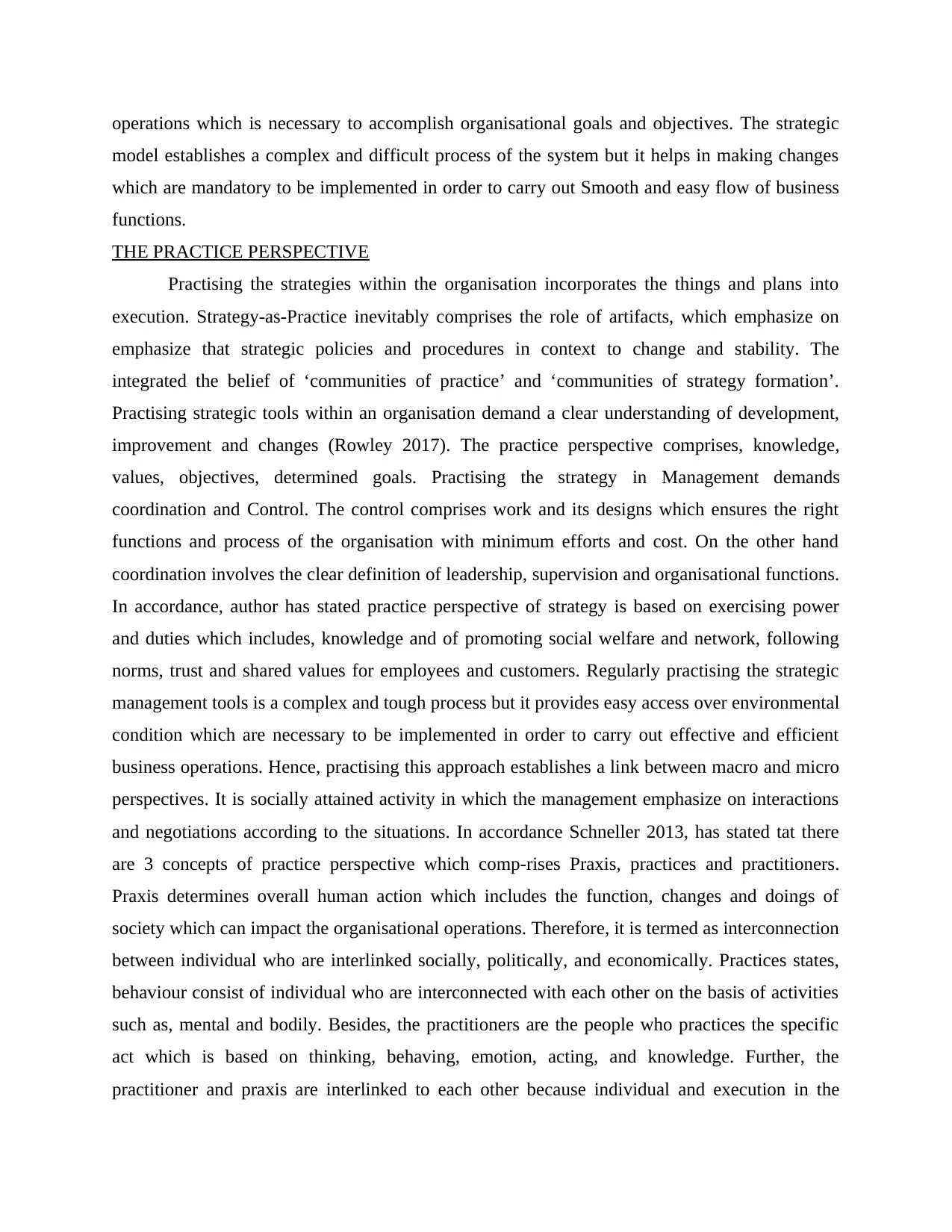
operations which is necessary to accomplish organisational goals and objectives. The strategic
model establishes a complex and difficult process of the system but it helps in making changes
which are mandatory to be implemented in order to carry out Smooth and easy flow of business
functions.
THE PRACTICE PERSPECTIVE
Practising the strategies within the organisation incorporates the things and plans into
execution. Strategy-as-Practice inevitably comprises the role of artifacts, which emphasize on
emphasize that strategic policies and procedures in context to change and stability. The
integrated the belief of ‘communities of practice’ and ‘communities of strategy formation’.
Practising strategic tools within an organisation demand a clear understanding of development,
improvement and changes (Rowley 2017). The practice perspective comprises, knowledge,
values, objectives, determined goals. Practising the strategy in Management demands
coordination and Control. The control comprises work and its designs which ensures the right
functions and process of the organisation with minimum efforts and cost. On the other hand
coordination involves the clear definition of leadership, supervision and organisational functions.
In accordance, author has stated practice perspective of strategy is based on exercising power
and duties which includes, knowledge and of promoting social welfare and network, following
norms, trust and shared values for employees and customers. Regularly practising the strategic
management tools is a complex and tough process but it provides easy access over environmental
condition which are necessary to be implemented in order to carry out effective and efficient
business operations. Hence, practising this approach establishes a link between macro and micro
perspectives. It is socially attained activity in which the management emphasize on interactions
and negotiations according to the situations. In accordance Schneller 2013, has stated tat there
are 3 concepts of practice perspective which comp-rises Praxis, practices and practitioners.
Praxis determines overall human action which includes the function, changes and doings of
society which can impact the organisational operations. Therefore, it is termed as interconnection
between individual who are interlinked socially, politically, and economically. Practices states,
behaviour consist of individual who are interconnected with each other on the basis of activities
such as, mental and bodily. Besides, the practitioners are the people who practices the specific
act which is based on thinking, behaving, emotion, acting, and knowledge. Further, the
practitioner and praxis are interlinked to each other because individual and execution in the
model establishes a complex and difficult process of the system but it helps in making changes
which are mandatory to be implemented in order to carry out Smooth and easy flow of business
functions.
THE PRACTICE PERSPECTIVE
Practising the strategies within the organisation incorporates the things and plans into
execution. Strategy-as-Practice inevitably comprises the role of artifacts, which emphasize on
emphasize that strategic policies and procedures in context to change and stability. The
integrated the belief of ‘communities of practice’ and ‘communities of strategy formation’.
Practising strategic tools within an organisation demand a clear understanding of development,
improvement and changes (Rowley 2017). The practice perspective comprises, knowledge,
values, objectives, determined goals. Practising the strategy in Management demands
coordination and Control. The control comprises work and its designs which ensures the right
functions and process of the organisation with minimum efforts and cost. On the other hand
coordination involves the clear definition of leadership, supervision and organisational functions.
In accordance, author has stated practice perspective of strategy is based on exercising power
and duties which includes, knowledge and of promoting social welfare and network, following
norms, trust and shared values for employees and customers. Regularly practising the strategic
management tools is a complex and tough process but it provides easy access over environmental
condition which are necessary to be implemented in order to carry out effective and efficient
business operations. Hence, practising this approach establishes a link between macro and micro
perspectives. It is socially attained activity in which the management emphasize on interactions
and negotiations according to the situations. In accordance Schneller 2013, has stated tat there
are 3 concepts of practice perspective which comp-rises Praxis, practices and practitioners.
Praxis determines overall human action which includes the function, changes and doings of
society which can impact the organisational operations. Therefore, it is termed as interconnection
between individual who are interlinked socially, politically, and economically. Practices states,
behaviour consist of individual who are interconnected with each other on the basis of activities
such as, mental and bodily. Besides, the practitioners are the people who practices the specific
act which is based on thinking, behaving, emotion, acting, and knowledge. Further, the
practitioner and praxis are interlinked to each other because individual and execution in the
Paraphrase This Document
Need a fresh take? Get an instant paraphrase of this document with our AI Paraphraser
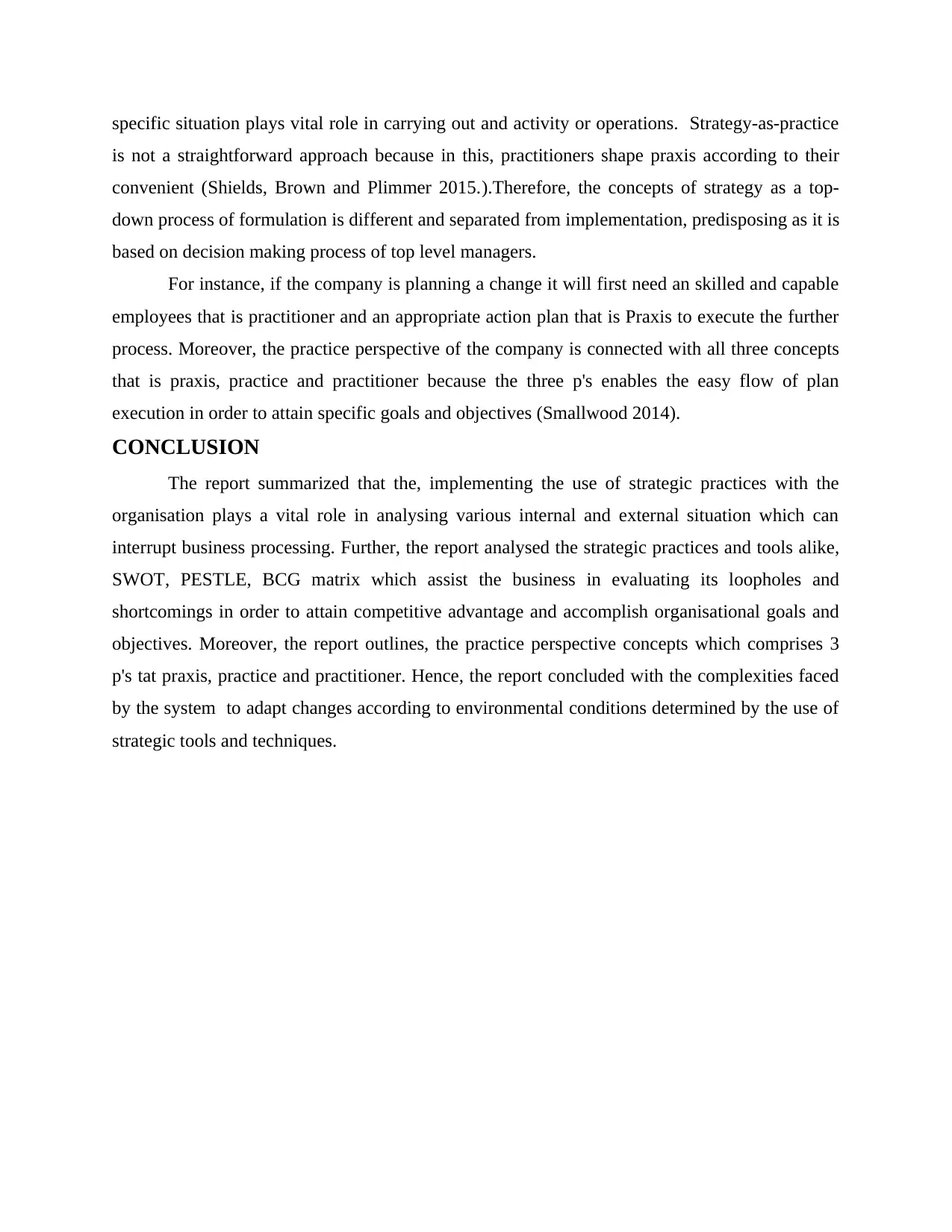
specific situation plays vital role in carrying out and activity or operations. Strategy-as-practice
is not a straightforward approach because in this, practitioners shape praxis according to their
convenient (Shields, Brown and Plimmer 2015.).Therefore, the concepts of strategy as a top-
down process of formulation is different and separated from implementation, predisposing as it is
based on decision making process of top level managers.
For instance, if the company is planning a change it will first need an skilled and capable
employees that is practitioner and an appropriate action plan that is Praxis to execute the further
process. Moreover, the practice perspective of the company is connected with all three concepts
that is praxis, practice and practitioner because the three p's enables the easy flow of plan
execution in order to attain specific goals and objectives (Smallwood 2014).
CONCLUSION
The report summarized that the, implementing the use of strategic practices with the
organisation plays a vital role in analysing various internal and external situation which can
interrupt business processing. Further, the report analysed the strategic practices and tools alike,
SWOT, PESTLE, BCG matrix which assist the business in evaluating its loopholes and
shortcomings in order to attain competitive advantage and accomplish organisational goals and
objectives. Moreover, the report outlines, the practice perspective concepts which comprises 3
p's tat praxis, practice and practitioner. Hence, the report concluded with the complexities faced
by the system to adapt changes according to environmental conditions determined by the use of
strategic tools and techniques.
is not a straightforward approach because in this, practitioners shape praxis according to their
convenient (Shields, Brown and Plimmer 2015.).Therefore, the concepts of strategy as a top-
down process of formulation is different and separated from implementation, predisposing as it is
based on decision making process of top level managers.
For instance, if the company is planning a change it will first need an skilled and capable
employees that is practitioner and an appropriate action plan that is Praxis to execute the further
process. Moreover, the practice perspective of the company is connected with all three concepts
that is praxis, practice and practitioner because the three p's enables the easy flow of plan
execution in order to attain specific goals and objectives (Smallwood 2014).
CONCLUSION
The report summarized that the, implementing the use of strategic practices with the
organisation plays a vital role in analysing various internal and external situation which can
interrupt business processing. Further, the report analysed the strategic practices and tools alike,
SWOT, PESTLE, BCG matrix which assist the business in evaluating its loopholes and
shortcomings in order to attain competitive advantage and accomplish organisational goals and
objectives. Moreover, the report outlines, the practice perspective concepts which comprises 3
p's tat praxis, practice and practitioner. Hence, the report concluded with the complexities faced
by the system to adapt changes according to environmental conditions determined by the use of
strategic tools and techniques.
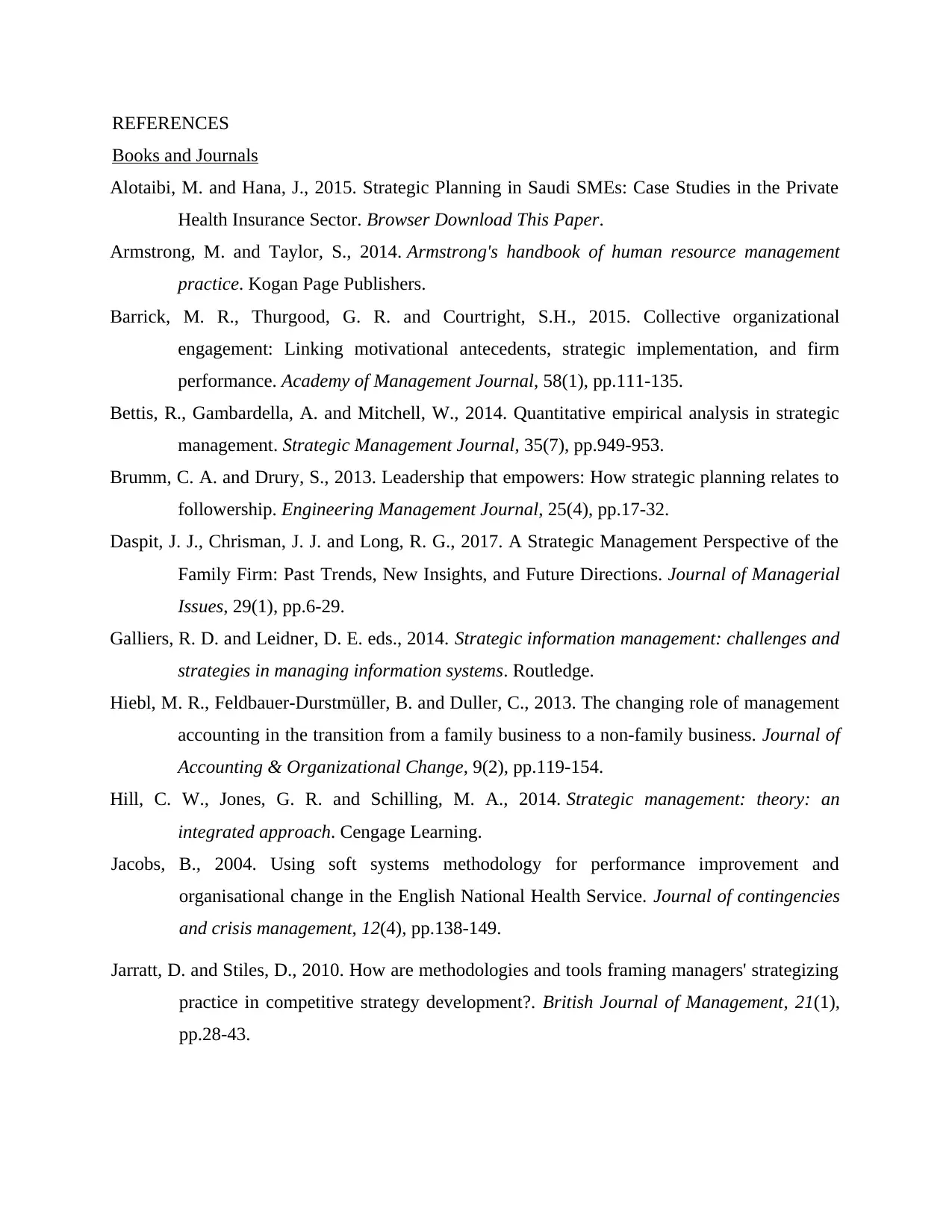
REFERENCES
Books and Journals
Alotaibi, M. and Hana, J., 2015. Strategic Planning in Saudi SMEs: Case Studies in the Private
Health Insurance Sector. Browser Download This Paper.
Armstrong, M. and Taylor, S., 2014. Armstrong's handbook of human resource management
practice. Kogan Page Publishers.
Barrick, M. R., Thurgood, G. R. and Courtright, S.H., 2015. Collective organizational
engagement: Linking motivational antecedents, strategic implementation, and firm
performance. Academy of Management Journal, 58(1), pp.111-135.
Bettis, R., Gambardella, A. and Mitchell, W., 2014. Quantitative empirical analysis in strategic
management. Strategic Management Journal, 35(7), pp.949-953.
Brumm, C. A. and Drury, S., 2013. Leadership that empowers: How strategic planning relates to
followership. Engineering Management Journal, 25(4), pp.17-32.
Daspit, J. J., Chrisman, J. J. and Long, R. G., 2017. A Strategic Management Perspective of the
Family Firm: Past Trends, New Insights, and Future Directions. Journal of Managerial
Issues, 29(1), pp.6-29.
Galliers, R. D. and Leidner, D. E. eds., 2014. Strategic information management: challenges and
strategies in managing information systems. Routledge.
Hiebl, M. R., Feldbauer-Durstmüller, B. and Duller, C., 2013. The changing role of management
accounting in the transition from a family business to a non-family business. Journal of
Accounting & Organizational Change, 9(2), pp.119-154.
Hill, C. W., Jones, G. R. and Schilling, M. A., 2014. Strategic management: theory: an
integrated approach. Cengage Learning.
Jacobs, B., 2004. Using soft systems methodology for performance improvement and
organisational change in the English National Health Service. Journal of contingencies
and crisis management, 12(4), pp.138-149.
Jarratt, D. and Stiles, D., 2010. How are methodologies and tools framing managers' strategizing
practice in competitive strategy development?. British Journal of Management, 21(1),
pp.28-43.
Books and Journals
Alotaibi, M. and Hana, J., 2015. Strategic Planning in Saudi SMEs: Case Studies in the Private
Health Insurance Sector. Browser Download This Paper.
Armstrong, M. and Taylor, S., 2014. Armstrong's handbook of human resource management
practice. Kogan Page Publishers.
Barrick, M. R., Thurgood, G. R. and Courtright, S.H., 2015. Collective organizational
engagement: Linking motivational antecedents, strategic implementation, and firm
performance. Academy of Management Journal, 58(1), pp.111-135.
Bettis, R., Gambardella, A. and Mitchell, W., 2014. Quantitative empirical analysis in strategic
management. Strategic Management Journal, 35(7), pp.949-953.
Brumm, C. A. and Drury, S., 2013. Leadership that empowers: How strategic planning relates to
followership. Engineering Management Journal, 25(4), pp.17-32.
Daspit, J. J., Chrisman, J. J. and Long, R. G., 2017. A Strategic Management Perspective of the
Family Firm: Past Trends, New Insights, and Future Directions. Journal of Managerial
Issues, 29(1), pp.6-29.
Galliers, R. D. and Leidner, D. E. eds., 2014. Strategic information management: challenges and
strategies in managing information systems. Routledge.
Hiebl, M. R., Feldbauer-Durstmüller, B. and Duller, C., 2013. The changing role of management
accounting in the transition from a family business to a non-family business. Journal of
Accounting & Organizational Change, 9(2), pp.119-154.
Hill, C. W., Jones, G. R. and Schilling, M. A., 2014. Strategic management: theory: an
integrated approach. Cengage Learning.
Jacobs, B., 2004. Using soft systems methodology for performance improvement and
organisational change in the English National Health Service. Journal of contingencies
and crisis management, 12(4), pp.138-149.
Jarratt, D. and Stiles, D., 2010. How are methodologies and tools framing managers' strategizing
practice in competitive strategy development?. British Journal of Management, 21(1),
pp.28-43.
⊘ This is a preview!⊘
Do you want full access?
Subscribe today to unlock all pages.

Trusted by 1+ million students worldwide
1 out of 14
Related Documents
Your All-in-One AI-Powered Toolkit for Academic Success.
+13062052269
info@desklib.com
Available 24*7 on WhatsApp / Email
![[object Object]](/_next/static/media/star-bottom.7253800d.svg)
Unlock your academic potential
Copyright © 2020–2025 A2Z Services. All Rights Reserved. Developed and managed by ZUCOL.





